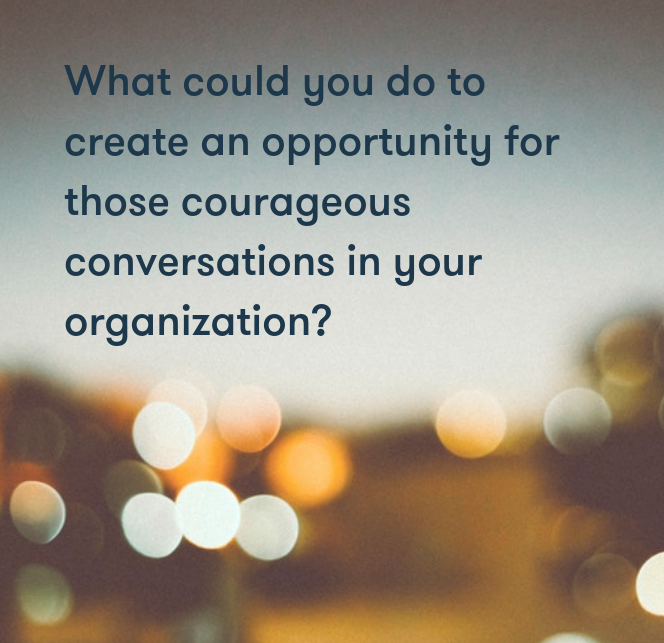COURAGEOUS CONVERSATIONS SERIES — PART I — WHAT ARE THEY AND WHY WE NEED TO HAVE THEM?
COURAGEOUS CONVERSATIONS SERIES — PART I — WHAT ARE THEY AND WHY WE NEED TO HAVE THEM?
Andrea McManus, ViTreo Group Inc
March 12th 2019
Most of us would prefer to avoid the ‘elephant in the room’, whether it’s in our personal or professional lives. Opening a discussion about difficult topics is never easy. But pretending there isn’t an issue or ignoring it means it never goes away. And as Shakespeare so eloquently put it, ‘That way madness lies.’
Not having the conversation means nothing changes. From an organizational perspective, it can result in goals left unrealized and lowered employee engagement and morale. As fundraisers and not for profit organizations, I think we need to have these discussions.
“One of the biggest predictors of decreased morale and trust in organizations is the perception of the proverbial ‘elephant in the room,’ when people do not feel free to discuss some of the most significant issues they face. Employee engagement and productivity decrease in the presence of ‘organizational silence,’ the phenomenon in which individuals have legitimate incentive to stay quiet rather than speak up (‘I’m not going to say anything…’).”
- Lead Change Group 5 Steps To Having Courageous Conversations 03/05/19
Holding these conversations is so important, events like The National Summit for Courageous Conversations (NSCC) now exist — it was created by the Pacific Educational Group as an annual venue designed “for educators, civic and community leaders, and other professionals who are committed to elevating individual and organizational racial literacy and consciousness to eradicate racial disparities that are predictably evident in achievement. The NSCC is PEG’s venue for bringing together the most promising and effective racial equity leadership voices, practices, and results for examination and broader dissemination across the United States and globally.” (Summit Courageous Conversations 03.05.19)
Creating Courageous Conversations
What do I mean by ‘courageous conversation’ in the nonprofit sense? I’m hard put to think of any sector that is at the mercy of so many myths. Whether it is the cost of fundraising, overhead, role in civil society or just the work that is done, we are constantly up against a multitude of widely-held, false, or just misinformed beliefs. Until we change our internal and organizational thinking around these, we won’t be able to influence the conversation externally.
In September 2018, NonProfit Quarterly published this article about some of the myths that are held around not for profits — Why Funding Overhead Is Not the Real Issue: The Case to Cover Full Costs, stating:
“Big strides have been made recently in the acknowledgment that overhead ratios are poor indicators of an organization’s impact or financial efficiency. Although the movement toward outcomes-based measurement offers a promising alternative to understanding impact, very little has been done to truly shift the sector’s understanding of what it takes - or even means - for nonprofits to be financially efficient and adaptable. The myths and misinterpretations of the true full costs of delivering vital programs have contributed to a chronically fragile social infrastructure for our communities.”
Addressing and resolving these issues internally in order to influence external beliefs means firstly, having a dialogue to understand each others’ viewpoints and secondly, to then have a discussion to achieve resolution or agreement or to make a decision. Only when we have solidified our own thinking around the barriers we face, can we hope to persuade external stakeholders.
One of the case studies from the AFP 2017 CFRE Refresher Course Discussion Caselets provides a great example of one of these types of conversations, where changes needed to be made internally, in order to influence and bring back donors (there are many other excellent examples in the course materials) — a large urban not for profit had a group of loyal donors who had regularly given in the < $1,000 range on an annual basis for the past 10 years. Little or nothing had been done in the way of stewardship. When a downturn in the economy occurred and a new, similar organization came to town, donations dropped, jeopardizing the original not for profit’s programming for the next year. In the case study, it was suggested that a conversation be created around the next steps the Development Director should take - what to do about the new organization, repositioning the organization within the community and working with these donors in the future. Some appropriate resolutions were set out: creating a cultivation plan, donor acquisition and retention, developing external spheres of influence and new governance models.
This is a great description of what these conversations should contain - first, dialogue and then discussion - from the Ontario Leadership Framework:
“Dialogue is a reflective learning process in which two or more people seek to understand each other’s viewpoints and deeply held assumptions. It is a conversation in which talking and listening by all parties creates a flow of meaning. Out of dialogue emerges a new and shared understanding. Dialogue is a tool for collective exploration of meaning – not a search for the right answer or the best solution.
Discussion is a conversation in which two or more people intend to come to some form of closure – either by making a decision, reaching agreement, or identifying priorities. Discussion involves convergent thinking focused on tasks. Having this type of dialogue means challenging the current practices of your organization. It also means listening to and acting on the feedback in order to foster improvement and growth.”
Courageous conversations take place to challenge current practices and to provide an opportunity for improvement and growth. Often, these conversations are not happening because of a fear of disapproval. For leadership, creating a culture where people feel safe to engage in these types of conversations without fear of repercussion is essential to a high performing organization - and to becoming one. Critical to the process is being open to learning and being able to express views frankly and without holding back because of a concern about judgement or consequences - defensiveness and blame have no place here.
And one of the critical steps to sustainable change is to also involve the organization’s board of directors. Good not for profit governance involves strategic leadership and a focus on the processes for decision making and strategy execution to advance the not for profit’s cause. Boards are key links to our communities and in that capacity should be our ambassadors, our champions of the truth.
Does a culture of openness exist in your culture? Or is there room for improvement? Are your people avoiding certain topics?
In March 2018, The Chronicle of Philanthropy published an article about how one charitable organization confronted its blind spots through open dialogue and discussion, What It Takes: How a Charity Confronted Its Lack of Diversity and Found New Strength. Lift is a national antipoverty organization that helps parents and caregivers in low-income families build confidence, key relationships, and financial stability. Lift’s founder and CEO, Kirsten Lodal, started the not for profit in 1998 and a 2010 expansion prompted her to begin thinking about diversity and the possibility her upbringing as a white upper middle class person - significantly different than Lift’s clients - might have led to some blind spots about the topic.
"I really started looking at: What’s going on in terms of my leadership, the culture? she says. “Where do we need to start to get help to make sure that this organization is one where staff can feel supported and [can] thrive - and not like they are being asked to all become mini versions of me or my co-founder?”
Lift went onto conduct a cultural audit to find out how its employees who were people of colour felt about the organization, interviewing more than 130 people including staff, volunteers and board members. Concerns were raised by interviewees about inclusivity and cultural sensitivity. The organization acted on those findings and made significant changes, including re-shaping its recruiting policies. (Chronicle of Philanthropy What It Takes: How a Charity Confronted Its Lack of Diversity and Found New Strength Stephen Voss 03.05.19)
Without the CEO being willing and open to having these discussions, nothing would have changed for Lift and the organization could have lost employees, volunteers and board members eventually, a costly and time consuming exercise. It may have also led to difficulty recruiting potential employees - previous or existing employees have the ability to leave comments and reviews about their employers on websites like Glassdoor Job Search.
What could you do to create opportunity for those ‘courageous conversations’ in your organization? Do they need to be with your employees? Board of Directors? Leadership?
Over the next few weeks, The Provocateur will dig deeper into specific areas where I think our sector needs to have these conversations, where we can influence change and create a different narrative.
If you have been part of one of these ‘courageous conversations’, let me know how it went? What changes came out of it?
Check out ViTreo's Braintrust as we bring you additional insights into what is and what will be important in philanthropy through our Weekly News Recap and our Podcast.
ABOUT THE AUTHOR
Andrea McManus, Chair, Board of Directors, Partner
ViTreo Group Inc
Andrea McManus is a Partner with ViTreo with over 30 years’ experience in fund development, marketing, sponsorship and nonprofit management. A highly strategic thinker and change maker, Andrea has worked with organizations that span the nonprofit sector with particular focus on building long-term and sustainable capacity.






